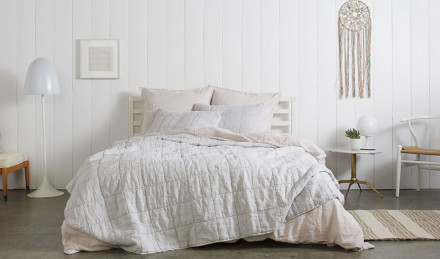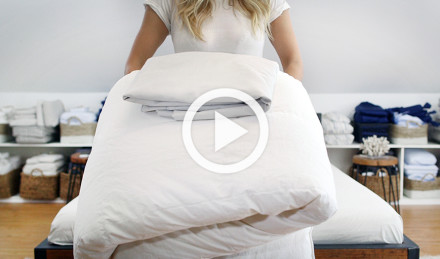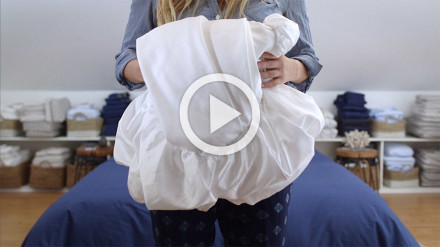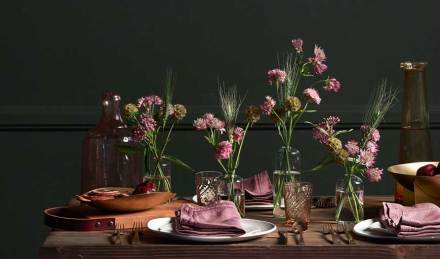If you can tell the difference between a fat quarter and a jelly roll, you might be a quilter. If not, have no fear. We’re here to illuminate the history, craft and timeless appeal of the quilt. A top of bed cover that’s passed down from one generation to the next, a quilt represents love, tradition, friendship – and warmth, of course. With such meaning represented in every stitch, a quilt collection was a natural addition to Parachute’s bedding assortment. Made of garment washed linen on the front and garment washed percale on the back, our Quilt, Quilted Shams and Quilted Euro Sham give the classic box pattern bed cover a modern twist. In honor of the quilt – now and then – some ‘essential’ history on what makes them so darn special…
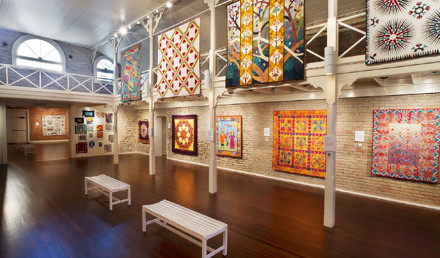
Patchwork Practicality
It wasn’t all ornate broadcloth and broderie perse for early American quilters. Only the wealthy had time for leisure quilting, and most quilts were created out of necessity. Not a single scrap was wasted — you could even say that colonial quilters were the original up-cyclers. A single quilt was frequently patched over and over again (or even combined with another quilt) to keep these practical heirlooms in functional form for multiple generations.
Patchwork Practicality
It wasn’t all ornate broadcloth and broderie perse for early American quilters. Only the wealthy had time for leisure quilting, and most quilts were created out of necessity. Not a single scrap was wasted — you could even say that colonial quilters were the original up-cyclers. A single quilt was frequently patched over and over again (or even combined with another quilt) to keep these practical heirlooms in functional form for multiple generations.
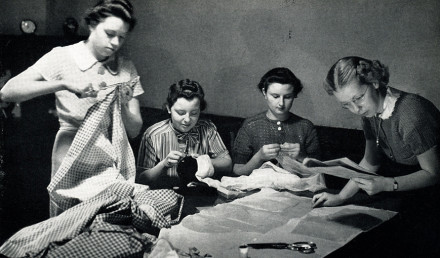
Social Stitching
Sewing circles were a place to lay down some stitches, gossip and even do some community organizing. Advances in textile manufacturing combined with the introduction of the sewing machine in 1846 allowed more women to undertake creative — and collaborative — projects. Album quilts became a popular style for circles, with each sewer responsible for stitching a single square. Quilts were often created to mark a significant event in the community like a birth or marriage. In abolitionist circles, intricate quilts were auctioned off as fundraisers, while simpler pieces were supplied directly to Northern soldiers.
Social Stitching
Sewing circles were a place to lay down some stitches, gossip and even do some community organizing. Advances in textile manufacturing combined with the introduction of the sewing machine in 1846 allowed more women to undertake creative — and collaborative — projects. Album quilts became a popular style for circles, with each sewer responsible for stitching a single square. Quilts were often created to mark a significant event in the community like a birth or marriage. In abolitionist circles, intricate quilts were auctioned off as fundraisers, while simpler pieces were supplied directly to Northern soldiers.
Sew Your Own Way
Victorian quilters ditched traditional geometric patterns for “crazy quilts” which combined a hodgepodge of fabrics and embellishments. Sumptuous combinations of velvet and silk, satin and tulle were all fair game for these labor intensive quilts — a full size crazy quilt could require up to 1,500 hours of work! Traditional utilitarian designs remained popular though, especially in times of uncertainty. Meditative and relatively frugal, quilting was an especially popular hobby during the Great Depression in America.
Sew Your Own Way
Victorian quilters ditched traditional geometric patterns for “crazy quilts” which combined a hodgepodge of fabrics and embellishments. Sumptuous combinations of velvet and silk, satin and tulle were all fair game for these labor intensive quilts — a full size crazy quilt could require up to 1,500 hours of work! Traditional utilitarian designs remained popular though, especially in times of uncertainty. Meditative and relatively frugal, quilting was an especially popular hobby during the Great Depression in America.

Modern Makers
Sewing for social causes continues to be an important thread in the history of the quilt. Activist Cleve Jones conceived the AIDS Project AIDS Memorial Quilt in 1985 as a way to honor those who lost their lives to AIDS. Thirty years later, it holds the record as being the largest piece of craft art in the world, weighing 54 tons! New artisans are putting a fresh twist on quilted textiles to create wall-worthy pieces of art. Combining new technologies with traditional crafts techniques, modern quilters continue to stretch the art of the stitch.
Modern Makers
Sewing for social causes continues to be an important thread in the history of the quilt. Activist Cleve Jones conceived the AIDS Project AIDS Memorial Quilt in 1985 as a way to honor those who lost their lives to AIDS. Thirty years later, it holds the record as being the largest piece of craft art in the world, weighing 54 tons! New artisans are putting a fresh twist on quilted textiles to create wall-worthy pieces of art. Combining new technologies with traditional crafts techniques, modern quilters continue to stretch the art of the stitch.
Quilt Quiz — Don’t Worry, It’s Quick
Five fast facts to impress your sewing circle…or at the very least, your book club:
The word “quilt” entered the English language around 1300 and comes from the Latin word “culcita” — which means mattress or bolster. The use of “bee” in reference to a social gathering (like a quilting bee) emerged in the early 1800s and most likely references the industrious nature of the insect.
If you want to see one of the oldest quilt in the world, head to London. The Tristan Quilt, housed at the Victoria and Albert Museum, was created in Italy during the mid 1300s and depicts the romance of Tristan and Isolde stitched into a linen base.
Cross stitches and backstitches and zigzags are all at a good quilter’s fingertips. But which stitch is the most common stitch? That would be the running stitch, which typically leaves more thread visible on the top of the quilt than the backside.
The Whitney Museum of American Art was the first to exhibit quilts as fine art objects. The premier 1971 exhibition, Abstract Design in American Quilts, displayed more than 60 works and was met with critical praise.
Take a half-yard of fabric and cut it in half vertically — voila, you have the measurement quilters refer to as a “fat quarter” (typically 18” x 22”). “Jelly roll” is the name for thin, precut strips that can be bought in bulk.
Quilt Quiz — Don’t Worry, It’s Quick
Five fast facts to impress your sewing circle…or at the very least, your book club:
The word “quilt” entered the English language around 1300 and comes from the Latin word “culcita” — which means mattress or bolster. The use of “bee” in reference to a social gathering (like a quilting bee) emerged in the early 1800s and most likely references the industrious nature of the insect.
If you want to see one of the oldest quilt in the world, head to London. The Tristan Quilt, housed at the Victoria and Albert Museum, was created in Italy during the mid 1300s and depicts the romance of Tristan and Isolde stitched into a linen base.
Cross stitches and backstitches and zigzags are all at a good quilter’s fingertips. But which stitch is the most common stitch? That would be the running stitch, which typically leaves more thread visible on the top of the quilt than the backside.
The Whitney Museum of American Art was the first to exhibit quilts as fine art objects. The premier 1971 exhibition, Abstract Design in American Quilts, displayed more than 60 works and was met with critical praise.
Take a half-yard of fabric and cut it in half vertically — voila, you have the measurement quilters refer to as a “fat quarter” (typically 18” x 22”). “Jelly roll” is the name for thin, precut strips that can be bought in bulk.
